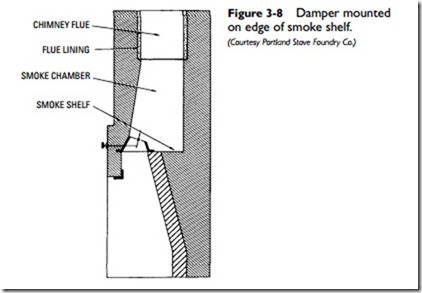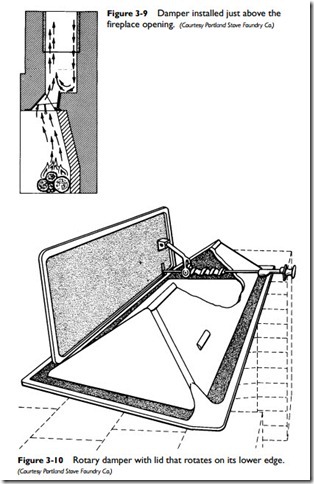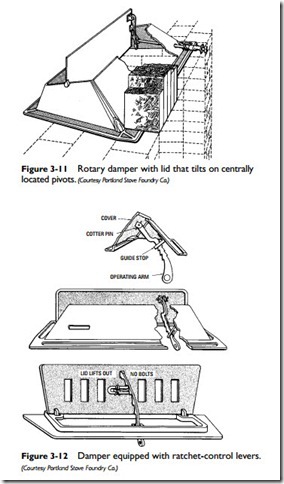Fireplace Hearth
The hearth is the surface or pavement in the fireplace on which the fire is built. The hearth is sometimes made flush with the floor and will extend out in front of the fireplace opening where it provides protection to the floor or floor covering against flying embers or ashes (see Figure 3-3). The recommended length of the hearth is the width of the fireplace opening plus 16 inches.
Ash Dump, Ashpit, and Cleanout Door An ashpit is a chamber located beneath the fireplace where the ashes from the fire are collected. An ash dump should be installed in the hearth toward the back of the fire- place. This is a metal plate that is pivoted so that the ashes can be easily dropped into the ashpit (see Figure 3-6). Ashes are
Smoke Chamber
The smoke chamber of the fireplace is a passage leading from the throat to the chimney flue (see Figure 3-4). It should be constructed so that it slopes at a 45° angle from the smoke shaft to the flue opening. The smoke chamber should also be constructed so that a smoke shelf extends straight back from the throat to the back of the flue line. The purpose of the smoke shelf is to prevent downdrafts from flowing into the fireplace. The damper should be mounted on the smoke shelf so that it covers the throat when it is closed. When open, the damper functions as a baffle against down- drafts.
Fireplace Dampers
One of the most frequent complaints about fireplaces is smoke backing up into the room. This condition, particularly if it persists, can usually be traced to a problem with the damper.
On very rare occasions, a fireplace and chimney will be built without a damper. When this is the case, the construction should be modified to incorporate a suitable damper; otherwise, it will be impossible to build and maintain a fire in the fireplace.
The damper should be installed at the front of the fireplace and should be wide enough to extend all the way across the opening. The two most common locations for a fireplace damper are shown in Figures 3-8 and 3-9. If the damper is placed higher up in the chimney, it is controlled with a long operating handle extending to just under the edge of the fireplace opening.
A rotary-control damper designed for use in the throat of a fireplace is shown in Figure 3-10. This particular damper has a tilting lid that rotates on its lower edge rather than on centrally located pivots like other rotary dampers (see Figure 3-11). The lid is operated by a brass handle attached to a rod that extends through the face brick or tiling over the fireplace opening. Dampers equipped with ratchet-control levers are shown in Figure 3-12.



